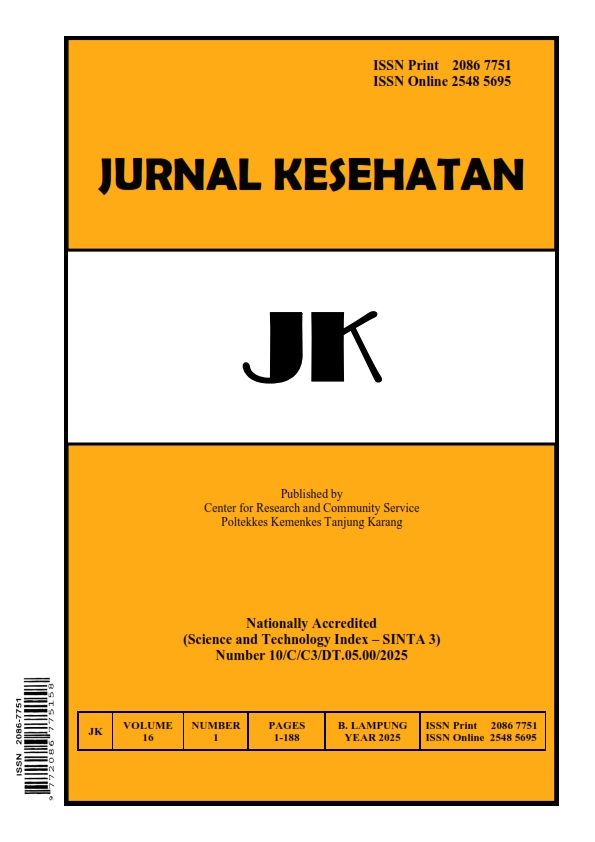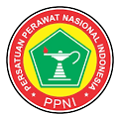Identification of Determining Factors of Stunting Prevalence
DOI:
https://doi.org/10.26630/jk.v16i1.4954Keywords:
Nutritional problem, Prevent stunting, ToddlersAbstract
Stunting is a chronic nutritional problem characterized by a toddler's height being below the standard for their age. This condition has long-term impacts on a child’s physical and cognitive development, as well as future productivity. This study was conducted to identify the determinant factors of stunting prevalence in Gunung Lurah Village, Cilongok Subdistrict, Central Java Province, Indonesia. The study employed a case-control design with a descriptive-analytic approach. The instruments used included the Kesehatan Ibu dan Anak book and questionnaires. The population in this study consisted of all mothers with toddlers in Gunung Lurah Village, totaling 648 individuals. The sample included mothers with stunted toddlers, totaling 43 (case group), and mothers with non-stunted toddlers, also totaling 43 (control group), with a 1:1 matching ratio, meaning the number of samples in the control group was equal to that in the case group. Bivariate analysis was conducted using the Chi-Square test, while multivariate analysis employed multiple logistic regression. The Chi-Square test results indicated that five out of nine factors studied had a significant association with stunting (p<0.05), namely parental knowledge (p=0.014), parenting style (p=0.004), exclusive breastfeeding (p=0.030), low birth weight (p=0.012), and socio-economic factors (p=0.001). The multiple logistic regression analysis revealed that socio-economic factors were the most significant determinant of stunting (p=0.001). This study concludes that socio-economic status is the main factor influencing the incidence of stunting. These findings are expected to serve as a basis for designing more effective programs to prevent stunting at the village level.
References
Achadi, E. L., & Endang, L. (2016). Investasi Gizi 1000 HPK dan Produktivitas Generasi Indonesia. Lokakarya Dan Seminar Ilmiah "Peran Profesi Dalam Upaya Peningkatan Status Kesehatan Dan Gizi Pada Periode, 1000, 12-13.
Apriani, S. R., Aqsha, R. K. D., & Zara, N. (2022). Studi Kasus Stunting pada Usia 34 Bulan di Desa Cot Mee Puskesmas Nisam Kabupaten Aceh Utara Tahun 2022. GALENICAL : Jurnal Kedokteran Dan Kesehatan Mahasiswa Malikussaleh, 1(2), 69.
https://doi.org/10.29103/jkkmm.v1i2.8095
de Onis, M., & Branca, F. (2016). Childhood stunting: A global perspective. Maternal and Child Nutrition, 12, 12-26. https://doi.org/10.1111/mcn.12231
Djauhari, T. (2017). Gizi Dan 1. Djauhari T. Gizi Dan 1000 HPK. Saintika Medika, 13(2), 129.
https://doi.org/10.22219/sm.v13i2.5554
Fajar, S. A., Anggraini, C. D., & Husnul, N. (2022). Efektivitas pemberian makanan tambahan pada status gizi balita Puskesmas Citeras, Kabupaten Garut. Nutrition Scientific Journal, 1(1), 30-40. https://doi.org/10.37058/nsj.v1i1.5975
Kirana, R., Aprianti, A., & Hariati, N. W. (2022). Pengaruh Media Promosi Kesehatan Terhadap Perilaku Ibu Dalam Pencegahan Stunting Di Masa Pandemi Covid-19 (Pada Anak Sekolah Tk Kuncup Harapan Banjarbaru). Jurnal Inovasi Penelitian, 2(9), 2899-2906.
Musheiguza, E., Mahande, M. J., Malamala, E., Msuya, S. E., Charles, F., Philemon, R., & Mgongo, M. (2021). Inequalities in stunting among under-five children in Tanzania: decomposing the concentration indexes using demographic health surveys from 2004/5 to 2015/6. International Journal for Equity in Health, 20(1), 1-10. https://doi.org/10.1186/s12939-021-01389-3
Ngaisyah, R. D. (2015). Hubungan Sosial Ekonomi Dengan Kejadian Stunting. Jurnal Medika Respati, X, 65-70.
Pantiawati, I., Widianawati, E., & Fani, T. (2023). Determinants of Stunting Based on Ecological Approach in Stunting Locus Area in Banyumas District. Jurnal Ilmu Kesehatan Masyarakat, 13(3), 376-384. https://doi.org/10.26553/jikm.2022.13.2.376-384
Par'i, H., Wiyono, S., & Titus Priyo, H. (2017). Penilaian Status Gizi. Jakarta: Kementerian Kesehatan Republik Indonesia.
Pratama, B., Angraini, D. I., & Nisa, K. (2019). Literatur Review: Penyebab Langsung (Immediate Cause) yang Mempengaruhi Kejadian Stunting pada Anak Immediate Cause Affects Stunting in Children. Jurnal Ilmiah Kesehatan Sandi Husada, 10(2), 299-303.
Putri, D. N. A., Sucipta, A. A. M., & Suryawan, I. W. B. (2024). Characteristics of stunting children and correlation between infectious diseases and severity of stunting at Wangaya General Hospital. Intisari Sains Medis, 15(3), 1284-1287.
Rachim, A. N. F., & Pratiwi, R. (2017). Hubungan Kosumsi Ikan terhadap Kejadian Stunting pada Anak Usia 2-5 Tahun. Jurnal Kedokteran Diponegoro, 6(1), 36-45.
Rajoo, Y., Ambu, S., Lim, Y. A. L., Rajoo, K., Tey, S. C., Lu, C. W., & Ngui, R. (2017). Neglected intestinal parasites, malnutrition and associated key factors: a population based cross-sectional study among indigenous communities in Sarawak, Malaysia. PloS One, 12(1), e0170174.
https://doi.org/10.1371/journal.pone.0170174
Setiawan, E., Machmud, R., & Masrul, M. (2018). Faktor-Faktor yang Berhubungan dengan Kejadian Stunting pada Anak Usia 24-59 Bulan di Wilayah Kerja Puskesmas Andalas Kecamatan Padang Timur Kota Padang Tahun 2018. Jurnal Kesehatan Andalas, 7(2), 275.
https://doi.org/10.25077/jka.v7i2.813
Suardianti, N. P. S. D. (2019). Hubungan Pola Asuh Orang tua dengan Kejadian Stunting pada Balita Usia 24-59 bulan di Desa Singakerta Kecamatan Ubud Gianyar tahun 2019. [Diploma thesis]. Denpasar: Nursing Department, Politeknik Kesehatan Kemenkes Denpasar.
UNICEF. (2021). Southeast Asia Regional Report on Maternal Nutrition and Complementary Feeding. World Health Organization.
Wahyuni, I, S. (2009). Hubungan Tingkat Pengatahuan Ibu Tentang Gizi Terhadap Status Gizi Anak Balita di Desa Ngemplak Kecamatan Karang Padan Kabupaten Karanganyar. [Undergraduate thesis]. Suakarta: Universitas Sebelas Maret.
Wahyuni, D., & Fithriyana, R. (2020). Pengaruh Sosial Ekonomi Dengan Kejadian Stunting Pada Balita Di Desa Kualu Tambang Kampar. PREPOTIF : Jurnal Kesehatan Masyarakat, 4(1), 20-26. https://doi.org/10.31004/prepotif.v4i1.539
Wardani, Z., Sukandar, D., Baliwati, Y. F., & Riyadi, H. (2021). Sebuah Alternatif: Indeks Stunting Sebagai Evaluasi Kebijakan Intervensi Balita Stunting Di Indonesia. Gizi Indonesia, 44(1), 21-30. https://doi.org/10.36457/gizindo.v44i1.535
Downloads
Published
Issue
Section
License
Copyright (c) 2025 Era Milania Karmadani, Yektiningtyastuti Yektiningtyastuti

This work is licensed under a Creative Commons Attribution-ShareAlike 4.0 International License.
Authors who publish in this journal agree to the following terms:
- Authors retain copyright and grant the journal right of first publication with the work simultaneously licensed under a Creative Commons Attribution License (CC BY-SA 4.0) that allows others to share the work with an acknowledgment of the work's authorship and initial publication in this journal.
- Authors can enter into separate, additional contractual arrangements for the non-exclusive distribution of the journal's published version of the work (e.g., post it to an institutional repository or publish it in a book), with an acknowledgment of its initial publication in this journal.
- Authors are permitted and encouraged to post their work online (e.g., in institutional repositories or on their website) prior to and during the submission process, as this can lead to productive exchanges and earlier and greater citations of published work.












